There are quarters when metrics rise because markets rise and there are quarters when numbers increase because something deeper has shifted in how a network is used. Q3 2025 for @Polygon was the second kind. The growth across POL market cap, stablecoin settlement, DeFi liquidity and real-world asset issuance did not emerge from speculative momentum alone. It reflected a network that is beginning to settle into its role: an economic layer where payments, capital markets and on-chain commerce operate alongside consumer-scale applications. What stands out in this quarter is not merely growth, but coherence. The ecosystem is not expanding randomly. It is expanding with direction.
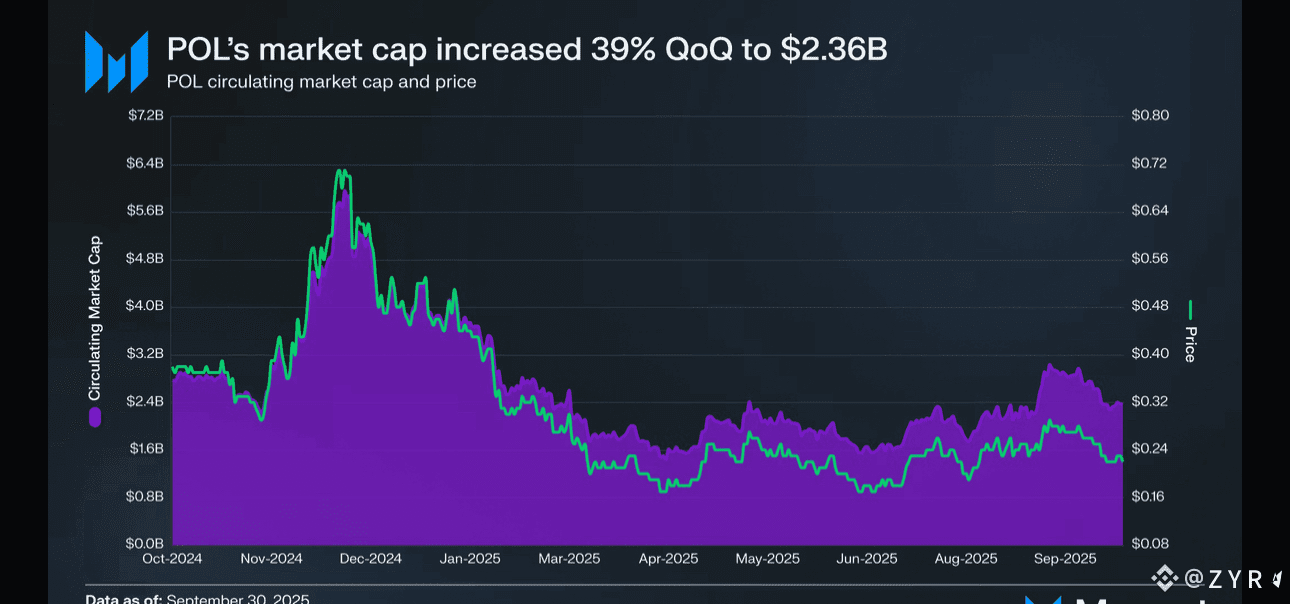
POL’s circulating market cap rose 39.2% quarter over quarter to $2.36 billion, outpacing the broader crypto market’s 20.7% increase. This signals something subtle but important: capital is differentiating between ecosystems. Investors are not spreading exposure evenly across chains. They are selecting networks that appear positioned for real usage, persistent applications, and multi-year relevance. Therefore, POL’s performance is not just a price movement. It is a reflection of belief returning to Polygon’s long-term architectural bet.
At the same time, Polygon PoS DeFi TVL closed the quarter at $1.14 billion. QuickSwap and Polymarket recorded QoQ TVL increases of 15.1% and 29.8%. What matters here is the nature of the liquidity driving this growth. This was not mercenary farm-and-exit capital. These flows came from applications with actual user activity. When liquidity is tied to real usage, it becomes sticky. Sticky liquidity forms the foundation for durable ecosystems. This is the difference between yield-seeking liquidity and application-anchored liquidity. Polygon is now increasingly supported by the latter.
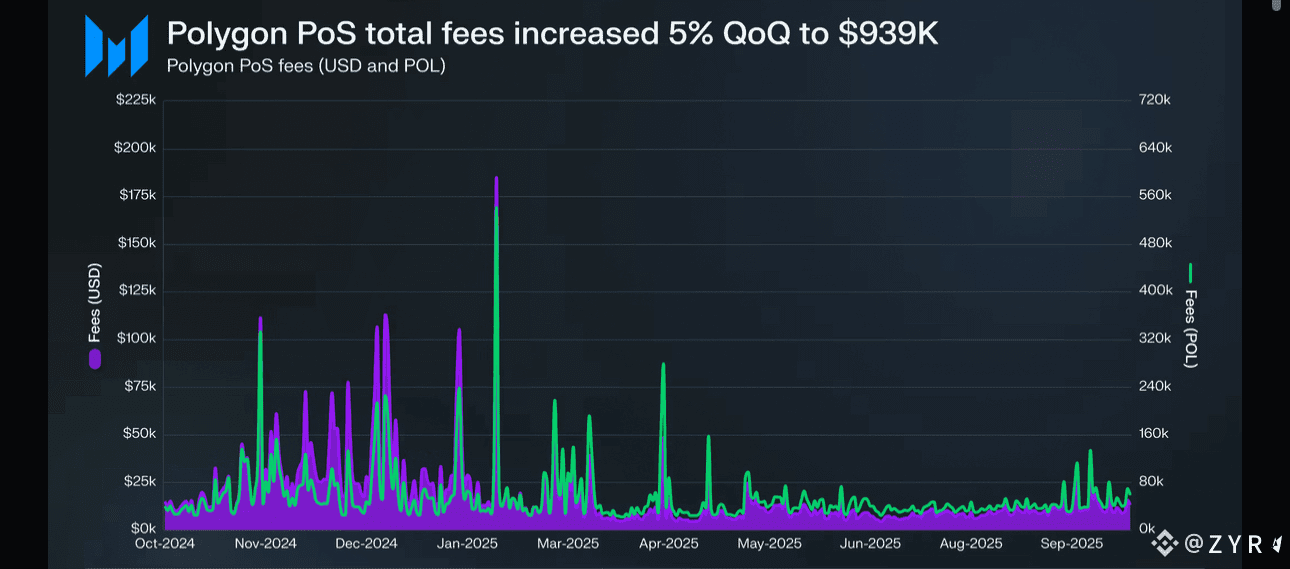
Meanwhile, stablecoin supply on Polygon PoS grew 22.0% QoQ to $2.94 billion. The increase was led by USDT, which expanded 35.4% QoQ to $1.4 billion. Stablecoin expansion is one of the clearest indicators of economic activity on a chain. Stablecoins are not speculative assets. They are instruments of transacting, storing value, hedging, paying, and moving money. When stablecoins expand, it suggests activity is increasing in ways that chart price cannot describe. Therefore, this quarter reflects growth in the base economic layer of Polygon, not simply its DeFi surface.
Payments activity reinforces this. Payments-focused applications processed $1.82 billion in transfer volume across more than fifty platforms, rising 49.2% QoQ. Stablecoin-linked crypto cards processed $322.2 million across ten Mastercard and Visa-connected programs. This is not theoretical adoption. This is settlement at retail, platform, and operational scale. When networks facilitate payments through familiar financial rails, they move from ecosystem to infrastructure. Polygon is operating in that transition space now.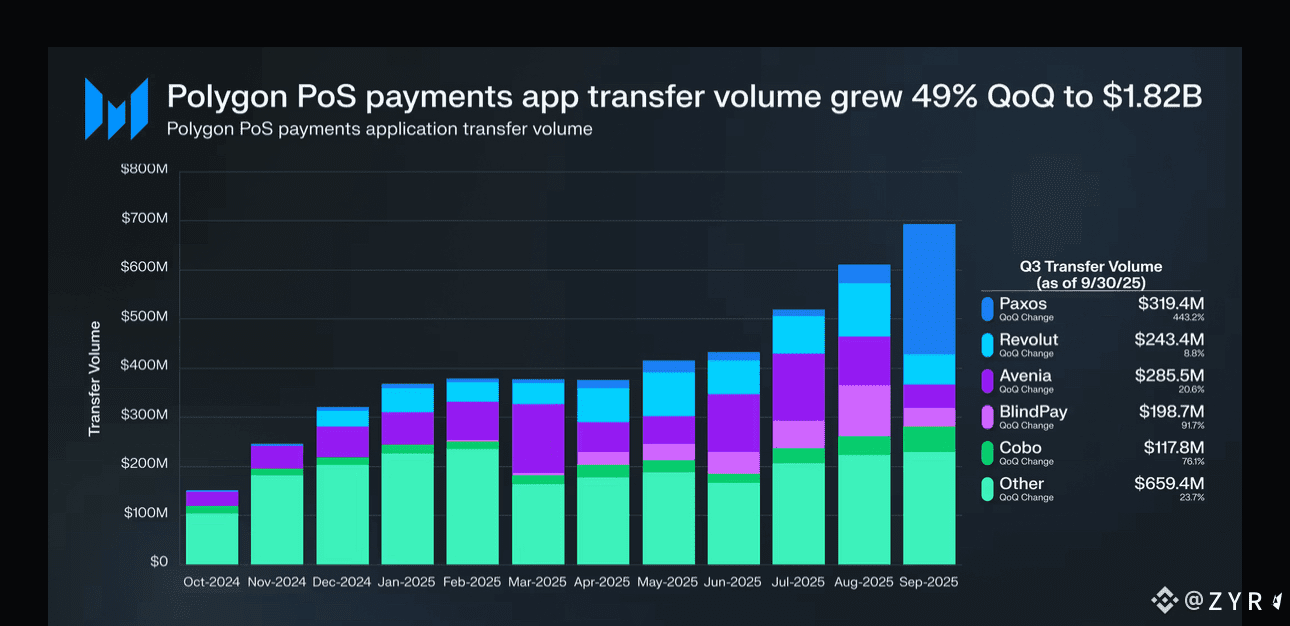
However, the strongest signal of structural maturity this quarter comes from real-world asset tokenization. Total RWA value on Polygon PoS reached $1.14 billion, driven by new institutional issuances from Justoken, NRW.BANK, BeToken, and the Philippines Department of Budget and Management. This matters because institutional RWA issuance is not cyclical. It does not expand and contract with market narratives. Once issued, on-chain assets tend to stay on-chain. They behave as long-duration proof of confidence. Therefore, each RWA issuance is not simply volume. It is a vote for Polygon’s legal, operational, and settlement reliability.
The final layer of the quarter’s picture is technical. The Bhilai Hardfork, Heimdall v2 upgrade, and Rio Testnet each move Polygon along the Gigagas roadmap toward higher throughput and faster finality. Scaling is not only about TPS. It is also about predictability, transaction sequencing integrity, and latency consistency. As Polygon moves toward over 5,000 TPS capacity, it is not simply increasing performance. It is clearing the path for thicker economic activity. A network cannot host consumer finance, commerce payments, global remittance, and RWA settlement without making blockspace feel abundant.
At this stage, the question shifts from whether Polygon is scaling to what that scaling enables. And this is where the narrative of the quarter becomes clearer.
A Shift from Access to Depth
During earlier cycles, Polygon positioned itself as the chain of access: low fees, easy onboarding, developer-friendly tooling. That positioning created adoption. But adoption alone is not endurance. Networks endure when usage deepens. In Q3 2025, Polygon began to shift from a network that is broadly used to a network that is deeply embedded.
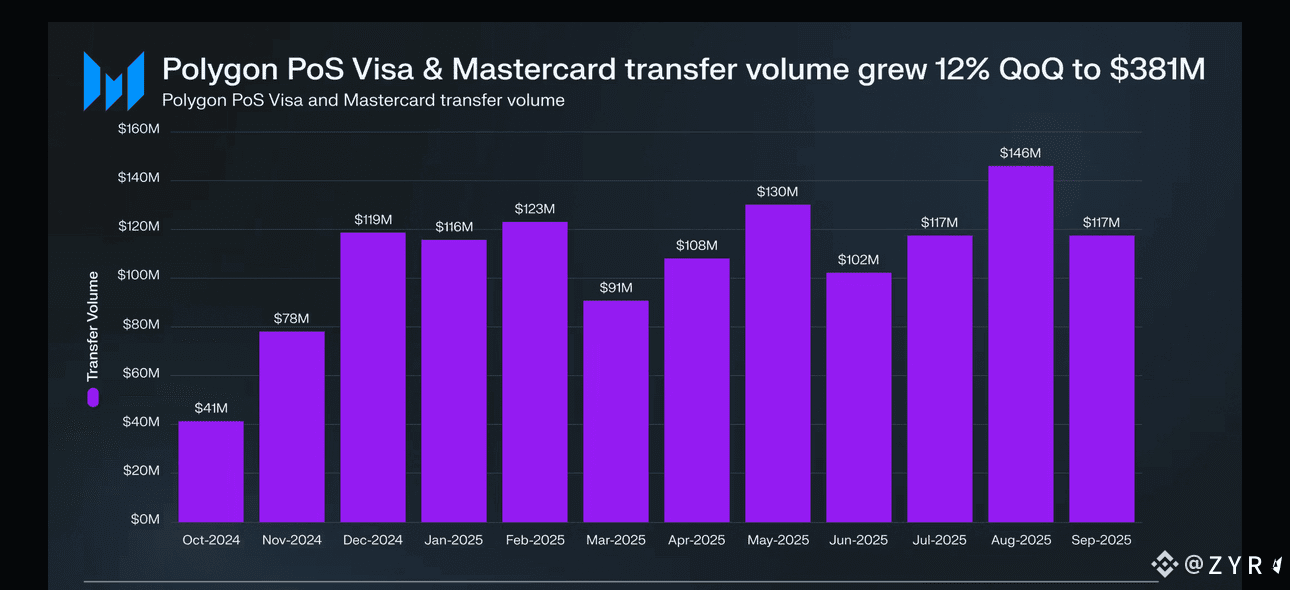
DeFi is not just providing yield. It is supporting liquidity for real markets. Stablecoins are not just held. They are circulated. RWA is not just discussed. It is issued. Payments are not speculative. They are operational.
The network is no longer defined by activity volume, but by purpose.
Why This Matters Now
Crypto is entering a stage where surface-level growth no longer convinces. What convinces is whether an ecosystem can support behaviors that look like the financial systems and digital economies people already recognize. Polygon is positioned here because it has spent years integrating:
Traditional financial institutions
Payment networks
Stablecoin providers
On-chain liquidity systems
Developer communities building consumer-facing products
These integrations were long, slow, and sometimes difficult. But they form the invisible foundation enabling the numbers we now see.
Therefore, Q3 2025 is not evidence of a breakout. It is evidence of a system reaching coherence.
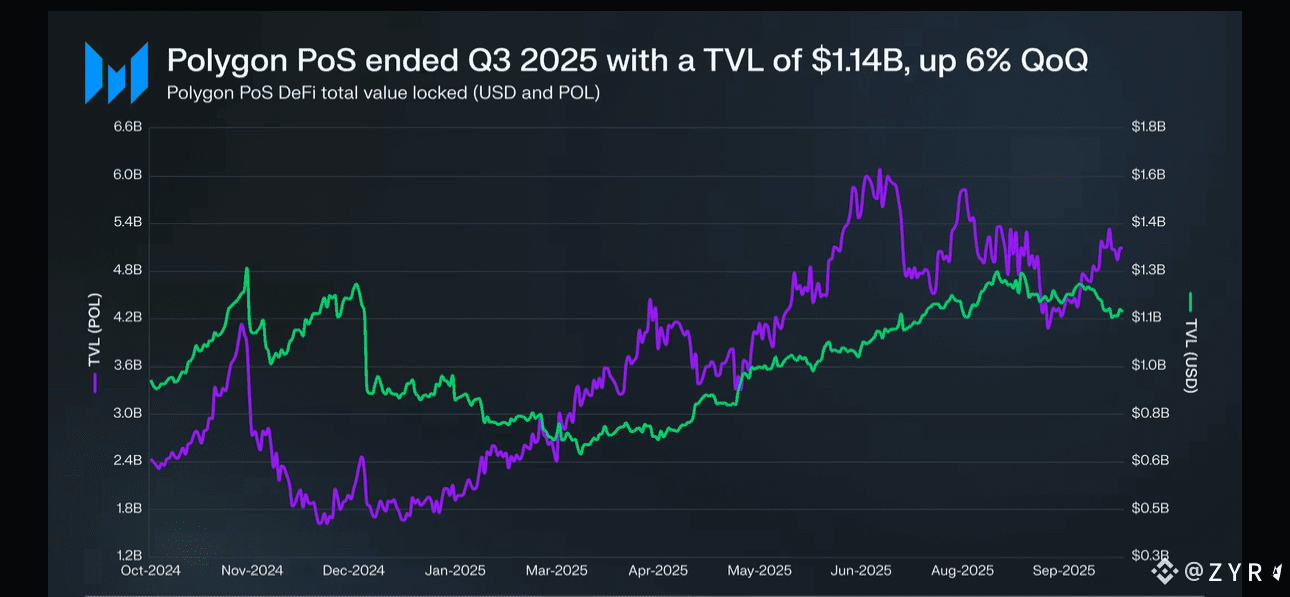
Depth Over Noise
As Polygon enters this next phase, what begins to stand out is how the ecosystem is behaving less like a typical smart contract platform and more like a layered economy. The activity we see in DeFi, payments, stablecoins, and real-world assets is not isolated growth. It is interconnected. Liquidity improves settlement conditions. Stablecoins improve transaction reliability. RWA issuance strengthens credibility. Payments reinforce velocity. Each component reinforces the others. Therefore, the network is not growing in separate verticals. It is growing in layers that compound.
To understand why this matters, consider how crypto ecosystems usually expand. In many cases, growth is driven by incentives. Liquidity arrives because yields are high. Applications scale because rewards are distributed. Narratives move capital faster than use cases do. This form of growth is sharp, but temporary. The capital that enters in search of incentives leaves when incentives normalize. The result is churn. Churn prevents maturity.
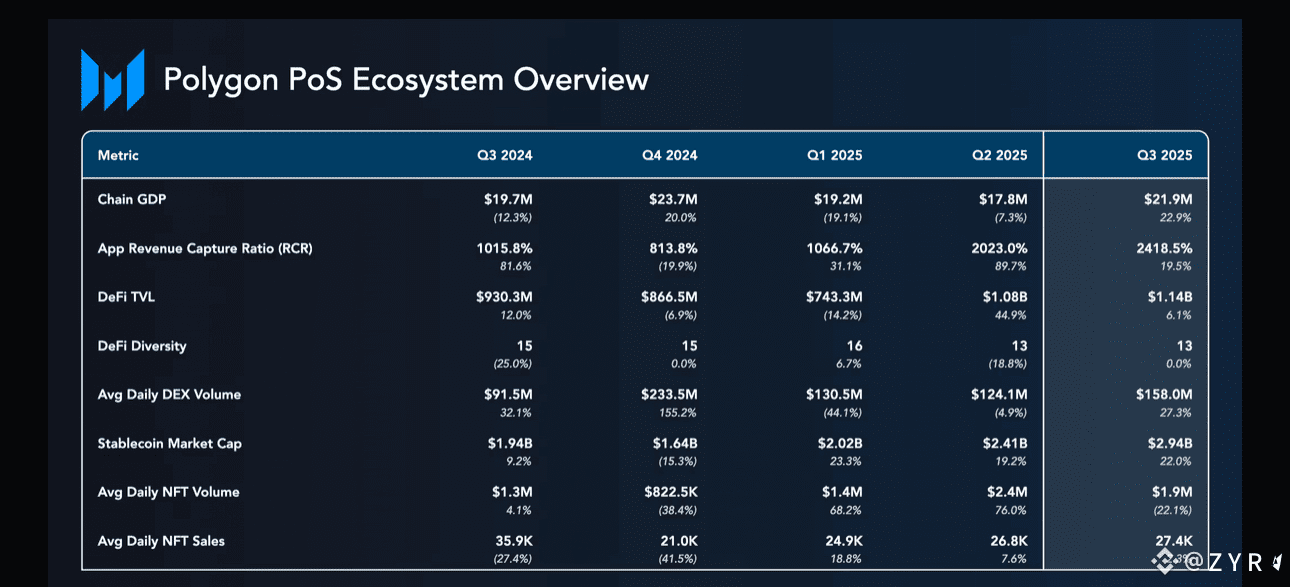
Polygons Q3 trajectory looks different. The liquidity entering QuickSwap, Polymarket, and other PoS DeFi platforms is not behaving like short-term farming capital. It is behaving like liquidity with purpose. Liquidity that supports trading depth, not just yield extraction. Liquidity that remains when rewards are modest because the market itself is active. When liquidity is anchored in real activity, it resists flight. That is how financial layers become stable.
The same dynamic appears in stablecoin supply. When stablecoin supply grows in speculative environments, the increase typically shows up in leveraged loops. When stablecoin supply grows during real usage phases, it shows up in circulation volume. Q3 data shows the latter. The $2.94 billion in stablecoin supply on Polygon PoS, led by the 35.4% expansion of USDT, aligns with rising transaction flows across payments and consumer-facing channels. In other words, stablecoins on Polygon are not sitting. They are moving.
Movement is economic truth.
Meanwhile, the payments layer is not simply expanding in volume. It is becoming structured. The $1.82 billion in transfer activity across fifty different applications did not come from a single dominant provider. It came from coordinated distribution across multiple services. This indicates that Polygon is not dependent on one flagship success story. Instead, it is building an economy with many operational nodes. This is a pattern associated with resilience.
The role of stablecoin-linked Mastercard and Visa programs is particularly relevant here. The $322.2 million processed across ten card programs shows that Polygon is bridging on-chain value to off-chain spending channels without requiring behavioral change from users. When on-chain value can be spent through familiar payment rails, adoption becomes frictionless. Frictionless adoption is adoption that scales quietly. It does not announce itself. It accumulates.
However, the RWA expansion is where the ecosystem begins to signal structural maturity. Institutional tokenization is one of the clearest indicators of whether a network is trusted for long-duration settlement. The $1.14 billion in RWA value issued on Polygon PoS this quarter represents commitments that stretch beyond market cycles. Public sector issuances, municipal participation, and regulated asset frameworks are not tactical decisions. They are strategic. Institutions do not settle on networks they believe may fail. They settle where they expect continuity.
@Polygon has been laying the groundwork for this since its earliest identity as a scaling solution. The shift toward the Polygon 2.0 architecture and the POL token economy has been driven by the recognition that networks must not only scale computation. They must scale trust. Trust does not expand simply because infrastructure improves. Trust expands when governance, usage patterns, institutional presence, and ecosystem coordination reinforce each other.
This brings us to the infrastructure upgrades. The Bhilai Hardfork, Heimdall v2, and Rio Testnet are often described in terms of throughput and finality, but their deeper role is strengthening the predictability of the network. At scale, predictability becomes more important than speed. Applications that support financial, public sector, or regulated use cases need confidence that finality will remain consistent and that reorg risks will not compromise record integrity. Therefore, Polygon’s upgrades are not simply performance enhancements. They are economic assurances.
A network that can guarantee predictable settlement behavior becomes viable for capital that cannot tolerate execution uncertainty. This is where Polygon’s direction aligns with the wider trajectory of crypto’s evolution. The market is moving from experimentation toward practicality. From novelty toward infrastructure. From speculation toward production.
Yet, none of this suggests that Polygon is trying to become an institutional-only ecosystem. What makes Polygon distinct is that the same network supporting RWA issuance, card payment settlement, and stablecoin velocity is also the network that supports gaming, consumer applications, on-chain communities, and decentralized autonomous collaboration. The network does not bifurcate between “retail usage” and “institutional usage.” It blends them.
This blending creates something rare: an on-chain economy that behaves like a market, not a siloed environment of isolated applications. Transactions influence liquidity. Liquidity influences pricing depth. Pricing depth influences volatility. Volatility influences trading. Trading influences issuance. Issuance influences settlement. The network becomes self-reinforcing.
At this stage, the role of POL becomes clearer. POL is not just a token for block rewards or governance signaling. It is the asset that coordinates security, staking, and chain orchestration across the broader Polygon ecosystem. As the network moves along the Gigagas roadmap, POL shifts from being a governance token to being a network utility asset. When tokens move from governance to utility, they gain economic meaning. They stop being symbols. They become instruments.
What follows from this is the beginning of a new kind of competitive advantage. Polygon is not competing on marketing. It is competing on settlement reliability, liquidity consistency, identity continuity, and application breadth. These are not short-cycle performance indicators. These are multi-year relevance indicators.
And relevance is what survives markets.
My Take
Polygon’s Q3 2025 looks like a network that is no longer trying to prove its existence. It is establishing its role. The growth in stablecoins, DeFi depth, RWA settlement, and payments shows a system that is not expanding for attention, but expanding because it is useful. The infrastructure upgrades are not chasing performance headlines. They are preparing for the scale that follows real adoption. This is the point where a network begins to feel less like a platform and more like an economy. And economies, when they reach coherence, do not fade. They compound.